The peso of which state is the national currency. Argentine peso - the currency of Argentina
The currency of Argentina is the peso. The name of the Argentine currency is quite common, because the peso is also used in Dominican Republic, Guinea-Bissau, in the Philippines.
Stages of development of the monetary system of Argentina
Note that National currency Argentina has always had this name, but from time to time the government was forced to carry out monetary reform due to strong inflation. To determine the period of circulation of currency in circulation, the following classification was introduced:
- pesos of the national currency (this is the very first stage);
- peso law no. 18188;
- argentine peso.
The currency of Argentina in its current form was issued by the Central Bank of the country in 1992, after another monetary reform.
Coins in Argentina
The National Bank of the country in 1992 issued coins in denominations from 1 centavo to 1 peso. I would like to talk about appearance And specifications coins. The reverse of the 1 centavo coin (issued until 2001) featured a laurel wreath. Disc diameter - 16.2 mm, weight - 1.77 grams. Since the currency of Argentina has been very unstable for more than 10 years, now the smallest coin is 5 centavos. It is 1 mm larger in diameter and 0.48 grams heavier. This brass-plated steel disc features a stylized sun.
10 centavos is a very popular coin today. Its diameter is 18.2 mm and the weight is identical to the previous coin. The coat of arms of Argentina flaunts on the reverse of this masterpiece. As well as in the Ukrainian gradation, the value of coins after the "tens" is 25 centavos. This coin is much wider and heavier than the previous ones. Its diameter is 24.2 mm, and its weight is as much as 6.1 grams. On metal money in denominations of 25 centavos, the town hall from the capital, Buenos Aires, is depicted. On a coin of denomination of 50 centavos - "House of Tucuman". It is 1 mm wider than the "twenty-five" but 0.3 grams lighter than it. Like all other coins, it is always minted from aluminum bronze.
Well, finally we got to the face value of 1 peso. The reverse features the coat of arms of the United Provinces of South America. The ring diameter is 23 mm, weight - 6.35 grams. In 2010, the Bank of Argentina introduced a new original coin of 2 pesos. Its rim is a ring made of an alloy of copper and nickel, and the middle is made of aluminum bronze. The painting is dedicated to the 200th anniversary of the May Revolution. Coin diameter - 24.5 mm, weight - 7.2 g.
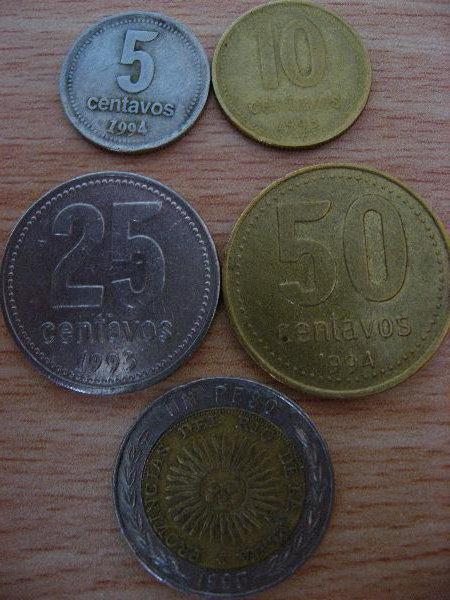
Currency of Argentina: banknotes
To date, paper money is in circulation in denominations of 2, 5, 10, 20, 50 and 100 pesos. There are both old banknotes (1997-1999) and new ones (2015-2016).
The sizes of banknotes, unlike many other currencies of the world, are standard - 65 x 155 mm. Paper denominations differ from each other in coloring and photographs.
The 2 peso paper is issued in blue and red colors. On the one hand, there is a photograph of the B. Miter Museum, and on the other, a portrait of the same person. The 5 pesos are in green and purple. On the obverse of the bill there is a portrait of Jose de San Martin, and on the reverse - a fragment of the Monument of Glory in the city of Mendoza. The currency of Argentina with a face value of 10 pesos is a brown-green rectangle with a portrait of the famous figure Manuel Belgrano on the obverse and one of the monuments located in the city of Rosario.

Lovers of red and yellow tones will definitely like the 20 peso bill with a portrait of Juan Manuel de Rosas and a photograph of the battle at sea at Obligado. "Fifty dollars" in Argentina is yellow-violet. On the obverse is a photograph of Domingo Faustino Sarmiento, and on reverse side we will see an image of the building of the Argentine government. The portrait of Julio Roca is depicted on the 100 peso bill. It is made in purple-brown tones. The pattern on the back of the banknote is very symbolic. Turning the banknote over, you can see the image of horsemen who arrived in new territories (conquerors).

Currency of Argentina: exchange rate against the ruble and other currencies
The peso is a very unstable currency. To date, it is also impossible to talk about the absence of crisis tendencies. For example, from 2002 to 2008 the dollar/peso ratio was 4:1, and in 2016 the exchange rate is 14:1. This is how the currency fluctuates in Argentina. The exchange rate also changes frequently against the ruble. As of mid-2016, the weighted average is as follows: 1 peso = 4.3519 rubles. The currency of Argentina is not much more expensive than the Ukrainian hryvnia (1 peso is 1.69 UAH). For a more complete picture of the "weight" of the monetary unit of this South American country, it is important to mention the exchange rate against the euro. On August 8, 2016, 100 pesos equals 6.0798 euros.
Argentina (official name – Republic of Argentina or Argentine Republic) is a state in the southeast of South America. The name of the country comes from the Latin word argentum (silver), since the country has large deposits of silver and platinum, which the Spaniards mistakenly took for impure silver during colonization.
The territory of Argentina is stretched from north to south, includes the northeastern part of the island Tierra del Fuego and the island of Estados. Argentina has common boundaries in the west with (the longest), in the north with , in the northeast with and in eastbound With . It is washed by the waters of the Atlantic in the east, which include the Strait of Magellan in the south (between the continent and Tierra del Fuego), the Strait of Lemaire in the southeast, and bays, in order from south to north, Baia Grande, Santa Jorge, San Matias and La Plata. The Falkland (Malvinas) Islands, lying to the east of the coast of the country, still remain disputed territory between Argentina and the UK. In the east and south of the country, the area has mountainous relief the southern tip of the Andes, and in the north in the valleys of the Parana and Uruguay rivers - flat and low. total area the territory of Argentina exceeds 2 million 700 thousand square kilometers.
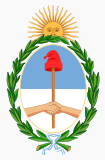
The population of Argentina exceeds 41 million people. By ethnic composition they are mainly Argentines, descendants of Indians and Spaniards, who formed the prevailing in given time ethnos. The country is home to quite a lot of immigrants from other countries, especially from Europe and Asia. It is worth noting that there is a large Ukrainian, Armenian and Russian diaspora in Argentina. State language in the country is Spanish.
Capital of the Republic of Argentina in this moment is the city of Bueno Aires, located on the shores of La Plata Bay and inhabited by more than three million inhabitants. Among the large and economically important cities of Argentina, one can single out such cities as Maar del Plata, Santa Cruz, Santa Fe, Cordoba and many others.
The history of Argentina is similar to the history of neighboring countries in the region. It is customary to start it from 1535, when the Spanish conquistadors led by Pedro de Mendoza arrived on the territory inhabited by Indians of different tribes and founded the city, which later became known as Buenos Aires. With the strengthening of Spanish rule in this region, at the end of 1776, the Vice-Kingdom of Rio de la Plata was formed, which included the territories modern states Argentina, and The Viceroyalty had Buenos Aires as its capital. At the beginning of March 1816, the independence of these territories from Spain and their division into separate states was proclaimed. Subsequently followed Civil War(1819) and a military conflict with, which ended with the victory of Argentina and the formation of the state. The history of Argentina in the 20th century is replete with dictatorial governments that consisted of the military. In a political crisis, the next military government of Galtieri got involved in a military conflict with Great Britain over the Falkland (Malvinas) Islands, which ended with the surrender of the Argentine garrison in this region.
Today, Argentina is a state with a stable democratic political power, but with an unbalanced economy, which suffered enough as a result of the 2001 default and is currently just beginning to emerge from the crisis.

The current currency of the Republic of Argentina is argentine peso(ARS code 032). The name of the national currency of Argentina is typical for a number of countries in South America. In Spanish, the word "peso" means small or small.
The very first currency of Argentina was also called the "peso", which was in circulation until 1987, when the currency unit called the Argentine austrel was introduced. In 1992, after another currency crisis and default, the austrel was replaced again by the peso.
At the moment, the exchange rate of the Argentine peso against the Russian ruble is such that for 10 Russian rubles when exchanging banks give about 1.6 pesos, for 1 US dollar - about 5 pesos, for 1 euro - 6.6 pesos.
The Central Bank of the Argentine Republic, which forms the country's financial policy, currently issued banknotes in circulation in denominations of 1 (one), 2 (two), 5 (five), 10 (ten), 20 (twenty), 50 (fifty) and 100 (one hundred) Argentine pesos. At the moment, coins in denominations of 1 (one), 2 (two), 5 (five), 10 (ten), 25 (twenty-five) and 50 (fifty) centavos are also in circulation, as well as coins with a denomination of 1 (one), 2 (two) and 5 (five) Chilean pesos. The one peso note is gradually being phased out and replaced by a corresponding coin.

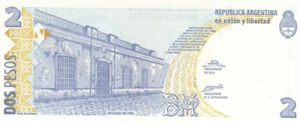




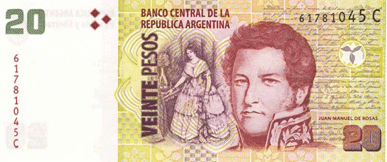
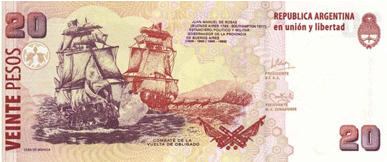
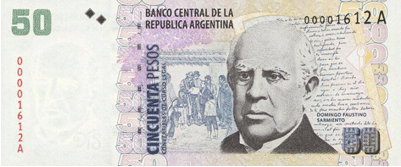


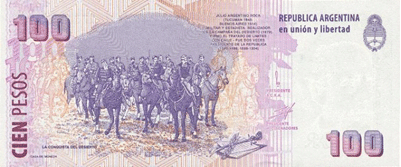
On the banknotes of Argentine pesos, on the front side, there are portraits of Argentine political and military figures who contributed to the history and formation of the country at different historical periods. So, on a bill of two pesos, a portrait of Bartolomeo Mitre, a famous Argentine figure of the 19th century, is depicted, in five pesos - Jose de San Martin, the leader of the national liberation movement for independence from Spain, in ten pesos - Manuel Belgrano, an Argentine politician, general and lawyer, twenty pesos - Juan Manuel de Rosas, Argentine military and political figure, fifty pesos - Domingo Faustino Sarmiento, military and political figure of the early 19th century, one hundred pesos - Julio Roca, military and political figure of the late 19th century, President of Argentina . The denomination of the banknote in digital format is shown in the lower right and upper right corners of the banknote. Scenes are depicted on the reverse side of the banknotes. historical events and architectural monuments. So, on a banknote of two pesos, the building of the Bartolomeo Miter Museum is depicted, at five pesos - the monument of national glory in Mendoza, at ten pesos - the national monumental ensemble of Rosario, at twenty pesos - a picture of the naval battle at Obligado, at fifty pesos - the building of the government of the country in Buenos Aires, in a hundred pesos - a group of cavalrymen who arrived on the developed lands. The denomination of the banknote in digital format is shown in the upper right and lower left corners of the banknote.
Banknotes of the Argentine Republic are printed at the National Mint of Argentina.
All coins of Argentina have a regular radially round shape. They differ in the material from which they are made, and in the design of the obverse and reverse. On the obverse, the heraldic symbols of the country and the Central Bank and profiles of the country's historical political figures are minted. On the reverse there is a denomination and a stylistic drawing.
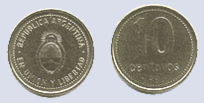

![]()
Argentine coins are minted at the National Mint of Argentina in the country's capital.
Tourists and guests of the country can exchange their currency at banking institutions in all without exception major cities countries. The commission for the exchange is charged at a rate of 3% of the exchange amount. You can make an exchange with private money changers, here the rate will be more profitable than with government agencies.
The Argentine Republic is located in South America and is one of the richest countries this region. The shores of its eastern part are washed by the waters Atlantic Ocean, which is very attractive for tourists from the most different countries. Also popular with travelers northwestern regions Andes, where you can do and have a good rest. Tourists often ask questions about what currency is in Argentina and what monetary units are in use. It must be said that the American dollar always remains in circulation in the republic, especially when it comes to visiting major cities And tourist centers. In a remote provincial area, it is necessary to have local money. The currency of Argentina is called the New Argentine Peso. In the international currency market, it is indicated by three initial letters ARS. There are smaller coins that are called centavos.
From the history of the country
The name of the state is translated from Latin as "silver". This is very symbolic, because the Spaniards arrived in Argentina specifically to search for this metal. For a long time the country was under their yoke and only in 1816 gained independence.
The beginning of the 20th century was the heyday of Argentina. European emigrants greatly enriched her and made her the richest on the continent. In 1976, power was in the hands of a military junta. In 1983, a democratic system was established in the country, but the original Argentinean ones remained under British rule. The economy of the state was greatly affected by the end of the twentieth century, from which Argentina was able to get out only by 2006.
Denomination of banknotes and coins
Argentine peso has a paper expression. There are also coins in denominations of one, two and five pesos. In the paper version, there are bills of two, five, ten, twenty, fifty and one hundred pesos. In addition, coins have circulation in the country - centavo. One peso is one hundred centavos. Before the advent of the current money, the currency of Argentina was called the austral.

Coins in Argentina are made from various metals such as brass, aluminum bronze, copper alloys, nickel and brass, copper and nickel. The state has a coin that is made of the purest gold. It is called "argentino" and has a denomination of one peso. On one side of the gold coin there is a coat of arms, and on the other side there is a woman representing Argentina.
Paper bills are all the same size - 155 by 65 millimeters. They are made from cotton fiber paper. The currency of Argentina has several degrees of protection, including
What does a peso look like
Paper banknotes depict the most beautiful and significant places states such as the Independence Monument, the President's Palace, the Miter Museum and the National Congress. WITH opposite side there are portraits of famous people in Argentina. Among them:

- Carlos Pellegrini. He was Vice President and President of Argentina. Became the founder of the bank and contributed to the exit of the country from economic crisis at the end of the 19th century.
- Juan Manuel de Rosas is a politician and head of the confederation in Argentina. He was one of the first dictators in Latin America. His image can be seen on the twenty peso banknote.
- Julio Argentino Roca - a politician who took part in the pacification of the Indians, for which he gained authority in high circles. He was elected twice and successfully coped with his duties. His portrait is featured on the 100 peso note.
- Domingo Fuastino Sarmiento - military figure, ambassador to the United States and president of Argentina. His portrait is featured on the fifty peso note.
- Manuel Belgrano - politician of the late 18th - early 19th centuries. He was engaged in advocacy, was a famous general. Featured on the ten peso note.
- José Francisco de San Martin is a national hero of Argentina. He led the movement of resistance to the colonialists. Featured on the five peso bill.
History of the Peso
The currency of Argentina until 1985 was called the old Argentine peso. As a result of the denomination, a thousand pesos were exchanged for one austral. The country was experiencing strong inflation, so there was a need for a new exchange. For ten thousand australs they gave one new peso. There was a new exchange on the last day of 1991. Until today, the new Argentine peso remains in use.
Exchange rates
The leadership of the state adheres to the policy of controlled navigation Among the Latin American countries, only Venezuela and Argentina follow this tactic. The currency, the exchange rate of which has been quite high for a long time, in Lately reduced by half. On the territory of the country in free circulation there are also American dollars. The big one is made by Visa cards and others.

The exchange rate of the Argentine peso against the dollar is 1:9, and against the euro - 1:9.5. Recently, there has been a fall in all major world currencies. This was also reflected in the Argentine peso.
Those who are going to spend an unforgettable holiday in Argentina should not forget that this is enough dear country. Until some time, even the Argentines themselves tried to go on vacation to cheaper countries, such as the United States or Brazil.
For visitors, according to the most conservative estimates, you will have to spend about five dollars a day on food, on average, about fifty dollars a day for food. Housing prices range from ten to one hundred and fifty dollars a day. The currency of Argentina is quite expensive, so tourists from the territory post-Soviet space do not always choose a country as a place to relax.

Argentina has a two-tier price system. For local population everything is cheaper, and for visiting foreigners - many times more expensive. The Argentinean currency is not stable enough. The country is in many ways going through moments of inflation, like many other states in modern world. However, the tourist flow to Argentina remains consistently high.



